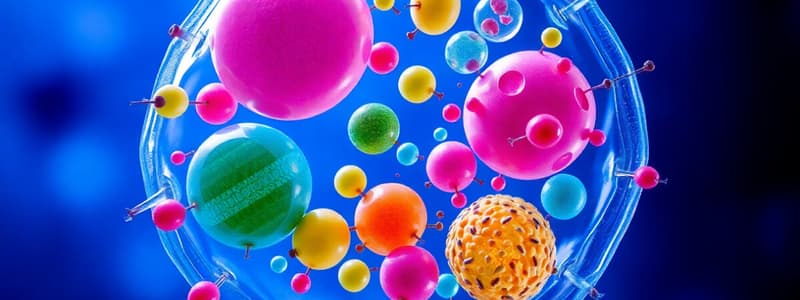Podcast
Questions and Answers
Which of the following best describes the primary function of peroxisomes?
Which of the following best describes the primary function of peroxisomes?
- Breakdown of fatty acids and detoxification of harmful substances (correct)
- Storage and transport of cellular materials
- Protein synthesis and modification
- Energy production through cellular respiration
What is the role of the central vacuole in plant cells?
What is the role of the central vacuole in plant cells?
- Cellular respiration
- Photosynthesis
- Maintaining turgor pressure and storing various substances (correct)
- Protein synthesis and packaging
Which component of the cytoskeleton is responsible for muscle contraction and cell movement?
Which component of the cytoskeleton is responsible for muscle contraction and cell movement?
- Microtubules
- Microfilaments (correct)
- Centrioles
- Intermediate filaments
What distinguishes chloroplasts from other organelles?
What distinguishes chloroplasts from other organelles?
Which of the following accurately describes the structure and function of microtubules?
Which of the following accurately describes the structure and function of microtubules?
Which organelle is responsible for generating energy in the form of ATP?
Which organelle is responsible for generating energy in the form of ATP?
What is the primary function of ribosomes within a cell?
What is the primary function of ribosomes within a cell?
Which organelle plays a crucial role in processing, packaging, and secreting proteins and lipids?
Which organelle plays a crucial role in processing, packaging, and secreting proteins and lipids?
What distinguishes rough endoplasmic reticulum (ER) from smooth ER?
What distinguishes rough endoplasmic reticulum (ER) from smooth ER?
Which cellular component contains the cell's DNA?
Which cellular component contains the cell's DNA?
What is the main function of lysosomes?
What is the main function of lysosomes?
What is the function of the central vacuole in plant cells?
What is the function of the central vacuole in plant cells?
Which description best fits the role of the nuclear envelope?
Which description best fits the role of the nuclear envelope?
Flashcards
Cell Organelles
Cell Organelles
Specialized compartments in cells that perform specific roles.
Nucleus
Nucleus
Control center of the cell that houses DNA.
Nuclear Envelope
Nuclear Envelope
Double membrane surrounding the nucleus, allowing traffic in and out.
Endoplasmic Reticulum (ER)
Endoplasmic Reticulum (ER)
Signup and view all the flashcards
Ribosomes
Ribosomes
Signup and view all the flashcards
Golgi Apparatus
Golgi Apparatus
Signup and view all the flashcards
Mitochondria
Mitochondria
Signup and view all the flashcards
Lysosomes
Lysosomes
Signup and view all the flashcards
Peroxisomes
Peroxisomes
Signup and view all the flashcards
Turgor Pressure
Turgor Pressure
Signup and view all the flashcards
Cytoskeleton
Cytoskeleton
Signup and view all the flashcards
Microtubules
Microtubules
Signup and view all the flashcards
Chloroplasts
Chloroplasts
Signup and view all the flashcards
Study Notes
Introduction to Cell Organelles
- Cells are the basic units of life, and to function efficiently, they contain a variety of specialized compartments called organelles.
- Organelles each have specific roles in the cell's metabolism and maintenance.
- Organelles are bound by membranes, defining boundaries and creating specialized internal environments, differing greatly from the cell's cytoplasm.
Nucleus
- The nucleus is the cell's control center, housing the cell's DNA.
- It's surrounded by a double membrane (nuclear envelope), perforated by nuclear pores, regulating traffic between the nucleus and cytoplasm.
- Inside the nucleus, DNA is organized into chromosomes.
- The nucleolus, a dense region within the nucleus, is responsible for ribosome synthesis.
Endoplasmic Reticulum (ER)
- The ER is a network of interconnected membranes throughout the cytoplasm.
- Two main types: rough ER (studded with ribosomes) and smooth ER (lacking ribosomes).
- Rough ER is involved in protein synthesis and modification.
- Smooth ER is involved in lipid synthesis, detoxification, and calcium storage.
Ribosomes
- Ribosomes are the cell's protein synthesis machinery.
- Found free in the cytoplasm or bound to the rough ER.
- Composed of ribosomal RNA (rRNA) and proteins.
Golgi Apparatus
- The Golgi apparatus is a stack of flattened membrane sacs, processing, packaging, and secreting proteins and lipids.
- Proteins and lipids are modified and sorted before transport to destinations within or outside the cell.
Mitochondria
- Mitochondria are the "powerhouses" of the cell, responsible for cellular respiration.
- Cellular respiration generates energy in the form of ATP.
- Mitochondria have their own DNA and ribosomes, suggesting an evolutionary origin from free-living prokaryotes.
- The inner membrane is highly folded to maximize surface area for ATP production.
Lysosomes
- Lysosomes are membrane-bound sacs with digestive enzymes.
- They break down cellular waste products, foreign substances, and cellular debris.
- The acidic internal environment of lysosomes is crucial for proper enzyme function.
Vacuoles
- Vacuoles are membrane-bound sacs with various roles, depending on cell type.
- In plant cells, the central vacuole stores water, nutrients, and waste products, maintaining turgor pressure.
- Animal cells may have smaller vacuoles for diverse functions.
Peroxisomes
- Peroxisomes are single-membrane bound organelles containing enzymes for various metabolic reactions.
- Including the breakdown of fatty acids and detoxification of harmful substances.
- They produce hydrogen peroxide as a byproduct, broken down by the peroxisome enzyme catalase.
Cytoskeleton
- The cytoskeleton is a network of protein filaments supporting cell structure and movement.
- Composed of three main types: microtubules, microfilaments, and intermediate filaments.
- Microtubules are hollow tubes for structural support, cell division, and intracellular transport.
- Microfilaments are thin, solid rods for muscle contraction, cell movement, and maintaining cell shape.
- Intermediate filaments provide structural support, anchoring organelles.
Chloroplasts (Plant cells only)
- Chloroplasts are the site of photosynthesis in plant cells and some protists.
- Chloroplasts contain chlorophyll, absorbing light energy for photosynthesis.
- They have a double membrane and internal membranes arranged in stacks called grana.
Studying That Suits You
Use AI to generate personalized quizzes and flashcards to suit your learning preferences.



